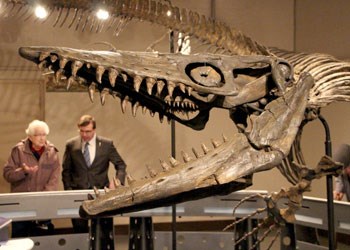The Western Development Museum has always been about showcasing Saskatchewan's past, and a new travelling exhibit will take visitors back over 70 million years. Om?c?w, Hunter of the Prairie Sea showcases a replica skeleton of a 10 meter long Tylosaurus which lived back when Saskatchewan was covered in water.
Tim Tokaryk, curator of paleontology for the Royal Saskatchewan Museum, explains that the skeleton shows how well adapted the Tylosaurus was to the undersea environment. He points to the bony plates around the eyes, which protected it while deep sea diving, as well as the complex mouth, with teeth on the top as well as a hinged jaw, ideal for grasping its prey.
"Saskatchewan, for the most part, from 100 million to 65 million years ago, we were underwater. While Alberta had the dinosaurs, we had these beasts swimming around... It was a serious eating machine that lived around 75 million years ago," Tokaryk says.
The fossil itself was discovered in 1994, north of Herbert in the Sask Landing area, after a hunter came across some bones, Tokaryk explains.
"Once you see bones that are in sequence, you connect the dots and have a pretty good idea that there is a good portion of a skeleton there."
Apart from showing what life was like when the province was underwater, the display exists to spark curiosity in people, young or old. Tokaryk says that he hopes that people become more interested in dinosaurs and fossils as a result of the exhibit, and that curiosity encourages people to continue learning about the history of the province.
"We don't really know much about the past in Saskatchewan, we are just scratching the surface, and some of these fossils are just so interesting that we have to share them with the people... There are many ages in the past that we can actually uncover in our own back yard," Tokaryk says.
The skeleton on display is a replica for the simple matter of practicality. The original fossil, explains Tokaryk, is extremely heavy, and any attempt to reinforce it for display would mean damaging the original piece. Using a replica allows the original to be protected and researched, to better understand how the Tylosaurus lived.
"When you put an original fossil on display, you actually have to drill through bone to have it display properly. When you do that, you distort the skeleton. [This replica] means that scientists generations from now can actually look at the original bones of Om?c?w and do their studies and references."
The exhibit will be on display until mid-May 2014.




